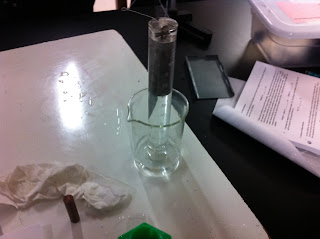Purpose
The purpose of this lab was to try a
variety of measurement methods in order to determine an experimental buoyant
force value.
Materials
Force Probe, String, Overflow Can, Beaker
to Catch Overflow, Metal Cylinders, Meter Stick, Ring Stand, Calipers
#1 Cup pressure test
#2 Act A : Cylinder submerged in water
#3 Act B: Measure the volume of the water overflowed
Under Water Weighting Method
We tied the metal cylinder to a piece of
sting (after weighing the metal cylinder) and tied the other end to a force
probe so that we could get a measurement of the tension of the object when we
submerged it through the force probe. We then obtained a ring stand and hung
our force probe from it so that we could get a less varying result. We submerged the hanging mass in our canister
of water and used the formula Buoyancy Force = Weight - Tension to find a
Buoyancy force of approx. 1.67 N.
Displaced Fluid Method
We prepared a overflow can and an
additional container to catch spill over water. We then placed the full
overflow can on the edge of the table and held the beaker underneath. After slowly lowering the metal cylinder into
the can of water and catching all of the spill over water we measured the
weight of the spill over water which using Archimede's principle is equal to
the buoyancy force 1.035 N
#4 Act B: Measure the volume of the water overflowed
Volume of Object Method
The last method we used is we determined the volume of the object which would also be the amount of water displaced when we inserted it to the overflow can. Thus we could find the weight of the displaced water by taking the volume of the object and multiplying the density of water. And using the Archimede's principle we can be sure that the two values are the same after conversion 1.01 N
#4 Act C: Measure the height of the cylinder
Questions:
1. The errors can be happen in the tolerance during the measuring and dropping water.
2. I believe that the Underwater Weighing Method is the most accurate one. Regarding to the method, tolerance could be reduced and the is no dropping water since the cylinder submerged in the water.
3. If the cylinder touches the bottom of the water container, the buoyant force would have been low. It is because the container's bottom proved a supporting force to the cylinder which reduce the buoyant force.





No comments:
Post a Comment